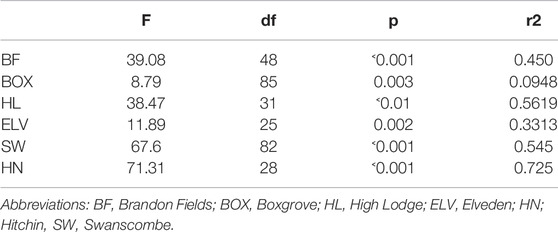- 1Institut Català de Paleoecologia Humana i Evolució Social (IPHES-CERCA), Tarragona, Spain
- 2Departament d’Història i Història de l’Art, Universitat Rovira i Virgili, Tarragona, Spain
- 3UMR 7194 Département Homme et Environnement, Museum National d’Histoire Naturelle, Paris, France
- 4Department Britain, Europe and Prehistory, British Museum, London, United Kingdom
- 5Institute of Archaeology, UCL, London, United Kingdom
- 6Department of Archaeology, Durham University, Durham, United Kingdom
The appearance of the Acheulean and the production of new bifacial tools marked a revolution in human behavior. The use of longer and complex operative chains, with centripetal and recurrent knapping, adapted to different raw materials, created long useful edges, converging in a functional distal end. How and why these handaxes vary has been the subject of intense debates. Britain provides a clearly defined region at the edge of the hominin occupied world for discussing variation in Acheulean assemblages. The environmental changes from MIS 15 to MIS 11 are significant in understanding population change, with probable breaks in evidence during MIS 14 and MIS 12, followed by several sites during the long stable climate of MIS11c. In this latter period, different Acheulean technological expressions appear to coexist in Britain. This paper draws together different studies, combining technology and geometric morphometrics to analyze handaxes from six British sites: Brandon Fields, Boxgrove (Q1B), High Lodge, Hitchin, Swanscombe (UMG), and Elveden. Compared to the earlier Acheulean of MIS 15, the assemblages of MIS 13 show increased standardization and the use of soft hammer percussion for thinning mid-sections and butts of tools, or sharpening tips through tranchet removals. Although there is regional population discontinuity through MIS12 there is no evidence of a marked change in technology after this glacial period. Rather, there is a development towards more intense shaping with the same underlying techniques, but with flexibility in imposed handaxe form. From MIS11 there appear to be distinctive localized traditions of manufacture, which suggest that a recognition of place and territories had developed by this time. These are expressed over medium time-scales of several thousand years and have significance for how we view cultural expression and transmission.
Introduction
The linked concepts of social learning, knowledge transfer and cultural transmission have long been recognized as important areas of early human research, particularly in relation to the development of complex technologies and cumulative culture (e.g., Mithen, 1994; Tomasello, 1999; Boyd et al., 2011; Pradhan et al., 2012; Dean et al., 2014; Henrich, 2015; Henrich and Tennie, 2017; Pargeter et al., 2019; Stout et al., 2019). But attempts to demonstrate the role of cumulative culture (Rosenberg-Yefet et al., 2021), and understanding the detailed mechanics of how they operate, have often been hindered by the large geographies and long timescales of the Lower Paleolithic record. The period is populated by short-term glimpses of human behavior, usually represented by lithic evidence that is scattered through space and time. Although this enables detailed behavioral insights or broad narratives of technological development, what is often missing between these short and long timescales is an understanding of how culture develops, is structured and persists at the millennial scale of several thousand years. In essence how did societies operate through multi-generational timescales in the Lower Paleolithic?
For Europe, questions of cultural transmission are particularly acute, as long-term cyclical changes in climates and environments led to ebbs and flows of population either between north and south or potentially with depopulation of the entire continent (Roebroeks, 2006; Dennell at al., 2011; Moncel et al., 2015). Often characterized as the ‘source and sink’ model, questions still remain about the boundaries between these zones, and whether cultural transmission was maintained throughout the Middle Pleistocene within Europe, or was dependent on source areas beyond.
Britain can be used as a laboratory for beginning to understand these concepts at the medium timescale. Middle Pleistocene research in Britain over the past 30 years has created a robust geological framework within which the abundant archaeological record can be placed (Bridgland, 1994; Bowen, 1999; Schreve, 2001; Penkman et al., 2011; Preece and Parfitt, 2012; Lewis et al., 2021). Work has highlighted the discontinuous nature of the record, which was due in part to successive glaciations, but also to Britain’s position as a cul-de-sac of Eurasia, tenuously linked to the main continent by a narrow isthmus of optimally 150 km wide during warm periods (Preece, 1995; White and Schreve, 2000; Hijma et al., 2012; Ashton et al., 2016; Ashton and Davis 2021). This specific geography appears to have led to a series of short-term population incursions into Britain with a diverse array of material culture manifested in simple core and flake assemblages and those with distinctive handaxe forms. Due to the resolution of the geological framework, these population incursions can sometimes be attributed to isotope substages, and for some MIS 11 sites attributed to pollen zones of a few thousand years within substages (Ashton et al., 2016; Davis and Ashton 2019). This detailed record enables interrogation of the meaning behind handaxe form at the medium timescale.
Variation in handaxe form in Britain was recognized from the inception of the subject (Evans 1872, 1897). But it was Roe (1968), building on the metrical work of Bordes (1961), who provided a structure within which site assemblages could be categorized, identifying seven major Groups with several sub-groups, based on linear dimension ratios. Through the following decades the groups were hard to interpret due to poor chronological resolution, but as dating has improved over the last 30 years work has refocused on Roe’s original groups (Bridgland and White, 2014, 2015; White, 2015; White et al., 2018). These papers have taken Roe’s original analyses with the addition of new sites, and suggest that there is chronological patterning in the British handaxe record. In parallel, a further series of papers have put forward the notion of a series of population incursions with differences in material culture, including those with distinctive handaxe forms (Ashton, 2016; Davis and Ashton 2019; Davis et al., 2021a; Ashton and Davis 2021).
All these studies used either published data, or standard metrical analyses, but over the last few years there has been increasing use of 3D morphometrics for analyzing variation in handaxe form (Lycett et al., 2006; Archer and Braun, 2010; Shipton, 2013; Shipton and Clarkson, 2015a; Herzlinger et al., 2017; Hoggard et al., 2019). This method was at the heart of the Marie-Curie funded Western European Acheulean Project (WEAP), which developed a unified technological analysis of handaxes in combination with 3D morphometrics (see below). These methods have been used in the current work drawing on analyses undertaken by Shipton and White (2020) in combination with those from the British sites studied for WEAP (García-Medrano et al., 2019; García-Medrano et al., 2020, submitted).
The purpose of this paper is to use handaxes from six key British Middle Pleistocene sites that span the period from MIS 15 through to MIS 11 to answer the following questions:
1 Are the distinctions in handaxe form that have been identified in previous studies, supported by the current analyses using the WEAP method?
2 Are there chronological patterns in the data between the different isotope stages?
3 Are there spatial patterns within any of the isotope stages?
The results will be used to examine long-term developments in technology between MIS 15, 13, and 11 of whether there are underlying trends that suggest elements of continuity in northern Europe, albeit outside Britain, or whether there are abrupt changes in technology between the isotope stages, indicative of much more southerly source areas for incoming populations. For MIS 13 and 11, the results will be used to show whether there are regional differences or similarities within these isotope stages, and what this may mean in terms of population and group cultural dynamics.
Materials and Methods
Archaeological Contexts
The six British sites that have been analyzed for this paper consist of Brandon Fields (MIS 15), Boxgrove and High Lodge (both MIS 13), and Elveden, Swanscombe and Hitchin (all attributed to the long, warm MIS 11c substage). The sites were selected because of the good resolution of their dating. The combination of glacial history, its relationship with terrace stratigraphy, good preservation of biological remains, and the wide deployment of aminostratigraphy enables correlation between sites and the Marine Isotope record (Ashton, 2016). They vary from assemblages collected in the late 19th century (Brandon Fields), to those more recently excavated (Boxgrove). They are all open-air sites from alluvial and lacustrine contexts and therefore inevitably are samples of landscapes and subject to a variety of taphonomic processes. Although the methods of recovery vary at the different sites, the inclusion of cores and flakes in the collected assemblages reflects thorough recovery, and not just selection of the finer pieces. As the study is focused on handaxes, the collected assemblages are likely to be representative of the wider handaxe populations. For this study, some of the assemblages were sub-sampled. This was achieved through a visual inspection of the entire assemblage with selection of consecutive boxes that appeared to be representative, rejecting incomplete handaxes. Brief descriptions of the sites are given below with references for more detailed information about the sites.
Brandon Fields is now an area of undulating hollows that mark former gravel pits on a hilltop to the south-west of Brandon, Suffolk. Handaxes and other artefacts were collected here from the late 1860s most notably by James Flower, who gave a clear description of the location and geology (Flower 1869; Evans 1872; Evans 1897). Recent fieldwork has confirmed the original descriptions, which interprets the gravel as being from the Timworth Terrace of the Bytham River dating to MIS 14 and that most of the assemblage derives from MIS 15 land-surfaces (Davis et al., 2021a; Lewis et al., 2021). The British Museum holds 148 of the handaxes, which consist of two condition types. Around 85% are rather crude in manufacture, elongated, thick, relatively abraded, and generally stained. The remainder are generally ovate in form, fresher condition and exhibit more patination. Although an absolute split between the two assemblage types is difficult, 50 were sampled for this study, which generally adhere to the first group of cruder forms.
High Lodge is also a River Bytham site, just 10 km south of Brandon Fields. It is situated in a disused clay pit with the first artefacts discovered in the 1870s. The clays yielded a core, flake and scraper industry, while overlying sands provided an assemblage of handaxes (Evans, 1872; Whitaker et al., 1891; Marr, 1921). Extensive excavation by the British Museum (1962–68 and 1988) established the geology and archaeological contexts of the site (Ashton et al., 1992; Lewis et al., 2021). The clays (Bed C) and overlying sands (Bed E) are floodplain sediments of the Bytham River dating to MIS 13, which were subglacially deformed during the Anglian glaciation (MIS 12). For this study 32 handaxes from Bed E were recorded.
Boxgrove is located above the Sussex coastal plain in the former Eartham Quarry that revealed a sequence of marine, freshwater and terrestrial sediments that formed beneath a marine-cut chalk cliff (Roberts and Parfitt, 1999; Pope et al., 2020). The site dates to late MIS 13 based on mammalian biostratigraphy. The chalk provided abundant flint raw materials for the archaeological horizons, which consist of extensive lithic scatters associated with butchered mammal remains. The main concentration of 414 handaxes was excavated from around the Q1B watering hole, from which 50 were recorded for the present paper.
Elveden (Suffolk) is a disused clay pit from which handaxes were recovered in the early 20th century, with more formal excavation in 1937 (Paterson and Fagg, 1940). The most recent fieldwork was from 1995 to 1999, which revealed that fine-grained lacustrine and fluvial sediments infill a small basin and date to the first half of the Hoxnian interglacial (MIS 11c; Ashton et al., 2005). The main handaxe assemblage was collected in the early 20th century with additional material from the two excavations, the latter being concentrated around the edges of the basin and likely dating to the peak interglacial (Hoxnian pollen zones IIc-III; Davis and Ashton, 2019). Adjacent chalk provided a nearby source of flint, while refitting and the fresh condition of the artefacts indicates that most of the assemblages are in primary context. In total 80 handaxes have been recorded from the site and held in several different museums. For this research the 29 complete handaxes in the British Museum collection were studied, including three from the 1990s excavations.
Swanscombe (Barnfield Pit) is located on the Orsett Heath terrace of the River Thames in Kent, where fluvial sediments are attributed to the Hoxnian interglacial (MIS 11c; Smith and Dewey, 1913; Ovey, 1964; Wymer, 1968; Conway et al., 1996). The Lower Gravel and Lower Loam contain non-handaxe assemblages and date to the first half of the interglacial (Hoxnian pollen zones I and II), while handaxe assemblages have been recovered from the Lower Middle Gravel and the Upper Middle Gravel, which date to the peak interglacial (Hoxnian pollen zones late II and III). For this study, we sampled 50 handaxes from the Wymer 1950s excavations of the Upper Middle Gravel, in combination 34 handaxes from undifferentiated Middle Gravels, collected by Marston in the middle decades of the 20th century. Both collections are held at the British Museum. The assemblages are in secondary context, but were probably derived from the nearby floodplain of the river, using local flint gravels as the source for raw material.
Hitchin. A series of clay pits around the town of Hitchin were exploited in the late 19th and early 20th centuries, from which handaxe assemblages were collected (Reid, 1897; Boreham and Gibbard, 1995). Most reports suggest that lacustrine sediments infill a basin or series of basins above Anglian till and glacial gravels. The stratigraphic position and palynology from the clays suggest that they date to the first half of the Hoxnian interglacial (MIS 11c). A thick sequence of overlying “brickearth” has been interpreted as a combination of colluvial, fluvial and aeolian deposits (Boreham and Gibbard, 1995). Over 60 handaxes were collected in the late 19th and early 20th centuries, many from a gravelly loam at the base of the ‘brickearth’ (Reid, 1897), although after Reid’s visit others were found in the Lake Beds alongside interglacial mammalian remains (Reid, 1898, p18, footnote) while a photograph taken in 1885 seems to put the find location of at least one handaxe to within the lacustrine sediments (Bloom, 1934, 39). Recent works (White et al., 2019; Shipton and White 2020) have suggested that two separate assemblages may be combined in the Hitchin sample, perhaps belonging to different parts of the same sub-stage (as found at Foxhall Road, Ipswich) or different sub-stages (as found at Swanscombe, Kent).
Methods
Each handaxe was analyzed from two points of view: as a single unit, and as the sum of three separately analyzed morpho-functional parts; the tip, mid-section, and butt (Table 1) (García-Medrano et al., 2020). The division of each tool into three parts is based on the metrical distinction of the distal part at 1/5 of length, and the proximal part as 4/5 of length from the tip (Roe 1968). As a single unit, each tool can be defined by a combination of features that make it unique: material and blank type, facial working, edge delineation, bifacial and bilateral symmetry, and number of scars. The technological features considered on the three tool sections are type of hammer, number of removal series, depth of scars on edges, invasiveness of scars on a tool’s surface, type of shaping and any patina variation.
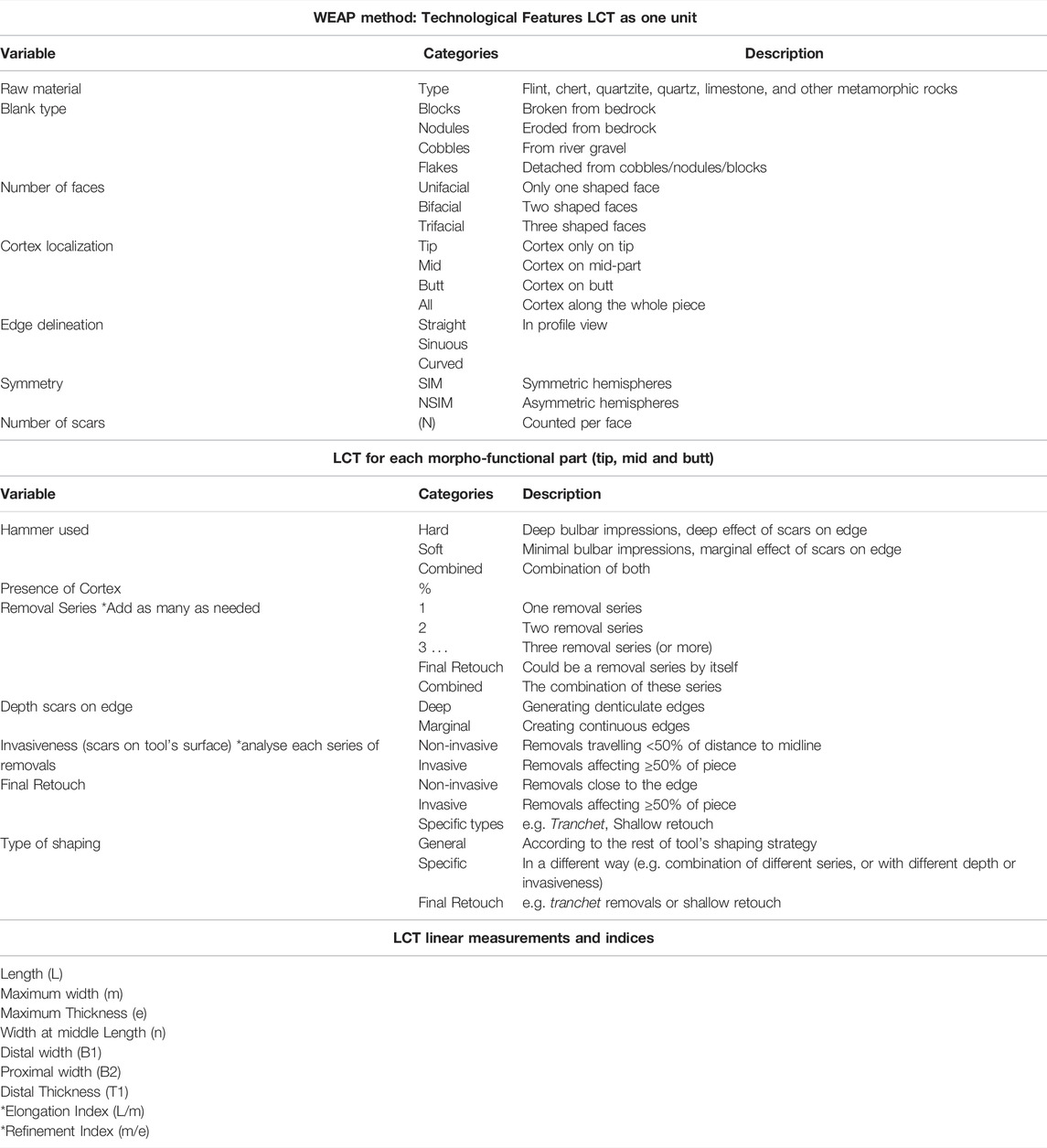
TABLE 1. Technological features and linear measurements considered to analyze LCT according to the WEAP Method.
Together with the technological descriptions, measurements were the basis of Bordes’ handaxe morphological types (“triangulaires”, “subtriangulaires”, “cordiformes”, discoid, ovate, and “limandes”) according to two main criteria: length against width, width against thickness (Bordes, 1961). However, the boundaries between the categories were sometimes imprecise, leading Roe (1968) to include three new measures: distal width (B1), proximal width (B2) and distal thickness (T1), to distinguish three shapes: pointed, ovate and cleaver-type tools. We retain all these measures to describe the tools, and compare the results with the morphological and technical features such as reduction intensity. The measurements have also been used to produce ratios to enhance handaxe description (Bordes 1961; Roe 1968, 1994). Elongation is given as length/width with values > 1.5 described as elongated. Refinement is measured by width/thickness with refined handaxes having values > 2.35.
This large set of technological features was combined by applying Correspondence Analysis (CA) to identify the differences and similarities of handaxes and cleavers as both complete tools and as three parts of a tool (tip, mid-section, and butt). The analysis also compared raw materials and types of blank. The Components 1, 2, and 3 were also explored with the Kruskal–Wallis non-parametric test to determine whether or not there are statistically significant differences between the medians of multiple assemblages, using PAST 3.14 software.
In addition to the technological analysis, we applied geometric morphometrics on 3D models to analyse tool shape variation. Tools were scanned both using DLP projector laser scanner and Flexscan software v.3.3.5.8. (LMI technologies, Canada) transferred from the Fragmented Heritage Project (University of Bradford), or a NextEngine and ScanStudio software. The 3D models were processed using the AGMT3-D software v.3.1 (Herzlinger and Grosman, 2018; Herzlinger and Goren-Inbar, 2020). This is a data-acquisition procedure for automatically positioning handaxe 3D models in space and fitting them with grids of 3D semi-landmarks. Each point of the grid consists of two semi-landmarks, one placed on each face of the artefact, so that a 50 × 50 grid provides 5,000 landmarks. This protocol provides a list of landmarks that accurately express the artefact’s volumetric configuration. It also provides a number of analytical tools and procedures that enable data processing and statistical analysis (Herzlinger and Grosman, 2018).
By examining the morphological deformations and XY plots of specimens from the PCA scatters, it is possible to interpret shape variation by itself and compare the different tools within a site or between different sites. In addition, the derived principal component scores allow for the application of other quantitative tests of multivariate equality of means between the groups (Costa, 2010; Herzlinger and Grosman, 2018; Herzlinger and Goren-Inbar, 2020). Specific multivariate analysis of variance (MANOVA) of the first 10 PCs helps to evaluate whether the differences between multiple groups are statistically significant or not. The alpha level for significance was determined as p < 0.05.
The latest version of this software (v.3.1) also offers different quantitative approaches to the analysis of specific variations in shape. First, we used the surface analysis and volume data to apply a quantitative approach to reduction intensity. The Scar Density Index (SDI, Clarkson, 2013; Shipton and Clarkson, 2015a, Shipton and Clarkson, 2015b) has been defined as the number of flake scars (greater than 10 mm in maximum dimension) divided by the surface area (in2). In addition, the landmark data was used to calculate the degree of deviation from perfect bilateral and bifacial symmetries, as well as the edge section regularity of each item in the sample (Herzlinger and Goren-Inbar, 2020). The bilateral symmetry analysis was conducted by measuring the mean 3D Euclidean distance between a mirror reflection of the landmarks placed on one lateral half of each object and the corresponding landmarks on the other half. The same procedure was performed for bifacial symmetry, but on the two opposing faces. In a perfect bilaterally or bifacially symmetrical object, the value of these indices will be 0, with increasing values indicating less symmetrical objects.
Results
Our sample comprises 311 flint handaxes from six archaeological sites, dated from MIS 15 to MIS 11c. For blank types, 18.97% of them are made on cobbles/nodules, 33.12% on flakes and in 47.59% of cases the intensity of shaping precluded blank type identification (Table 2).
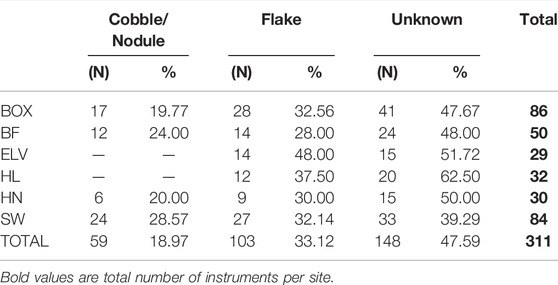
TABLE 2. Total number of instruments by type of blank (Cobble/nodule, Flake and Unknown) and sites (BOX, Boxgrove; BF, Brandon Fields; ELV, Elveden; HL, High Lodge; HN, Hitchin; SW, Swanscombe).
Metrically, our sample is standard with respect to the elongation of tools, but has a high inter-site variability with respect to the refinement (SOM Table 1). In fact, the morphological variation of the artefacts is mostly affected by their width and thickness (Table 3). Figure 1 explores these two indices by site and MIS. Boxgrove and High Lodge display a similar pattern with the most refined and least elongated. The MIS 15 site of Brandon Fields presents a lower median refinement value than any of the younger sites. MIS 11c sites reflect a clear common pattern, different from MIS 13 locations but similar to each other, with higher elongation and lower refinement values than MIS 13.
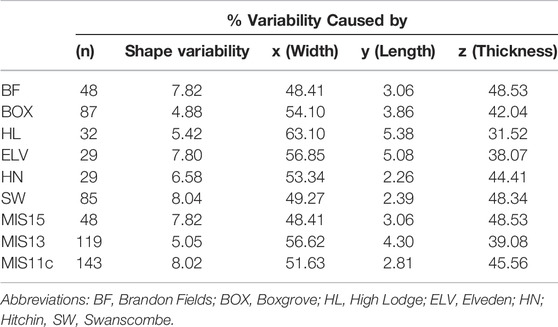
TABLE 3. Intra-assemblage shape variability analysis (mean multidimensional Euclidean distance of all artefacts from its centroid) and distribution of relative shape variability across dimensions of Figure 2.
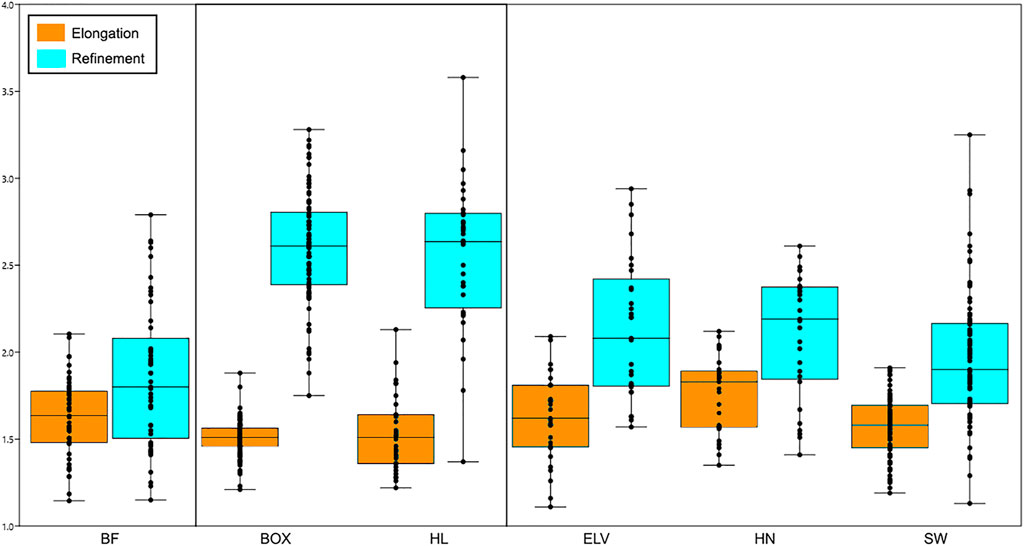
FIGURE 1. Boxplot with jitter of elongation and refinement values per sites. Abbreviations: BF, Brandon Fields; BOX, Boxgrove; HL, High Lodge; ELV, Elveden; HN; Hitchin, SW, Swanscombe.
Principal Component Analysis on 310 3D models produced 309 principal components (PCs) with 90.37% of the variability explained by the first 28 PCs. PC1 and PC2 together describe more than the 40% of the variability, which from positive to negative values represent for PC1 (27.71%) thin oval to thick pointed shapes, and for PC2 (12.34%) refined to thicker tools (Figure 2). MIS 13 sites are the least variable assemblages (Table 3), both Boxgrove and High Lodge containing more oval and refined shapes. Handaxes from Swanscombe are the most pointed and thickest tools. Wilcoxon Rank-sum test on interpoint distances between Boxgrove and Swanscombe indicate the morphometrical differences between them are statistically significant (ranksum = 20,638; n1 = 87; n2 = 85; p < 0.01). MIS 11c sites present much greater variability. Whereas Elveden’s mean shape is located at the centre of the graph, with a clear tendency to oval shapes, and the widest point closer to the middle of the tools, Hitchin and Swanscombe present more pointed shapes with their widest point towards the butt. The differences between these MIS 11 sites are statistically different (ranksum = 10,452; n1 = 29; n2 = 85; p < 0.01).
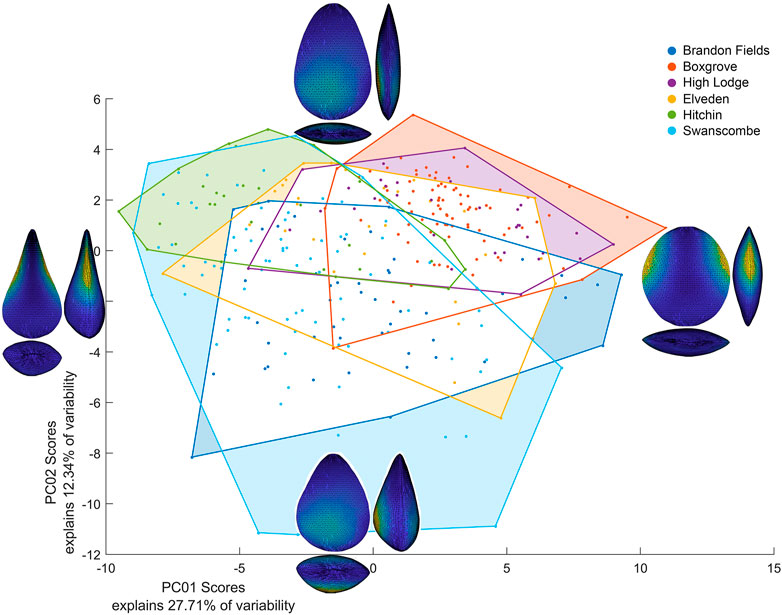
FIGURE 2. Geometric morphometrics: PCA on handaxe 3D models by sites. Illustrations show hypothetical objects situated at the extremities of each principal component, reflecting the shape trend it represents. Convex hulls represents the scatter plot limits on each site. The white area is the overlapped area.
With respect to symmetry (Table 4), the MIS 13 sites have lower mean values than other assemblages, something that may be related to the use of long shaping sequences, the degree of invasiveness of their removals, the use of soft hammer percussion (organic materials or potentially soft stone), with particular care to the edges. MIS 11c tools present the major irregularity. And in spite of the similarities between MIS 13 sites and the Elveden shaping strategies, Elveden handaxes show 300% more irregularity in their profiles than Boxgrove. This however is entirely the consequence of the deliberately imposed sinuous, twisted-profile shape which characterize this site (Figure 3).
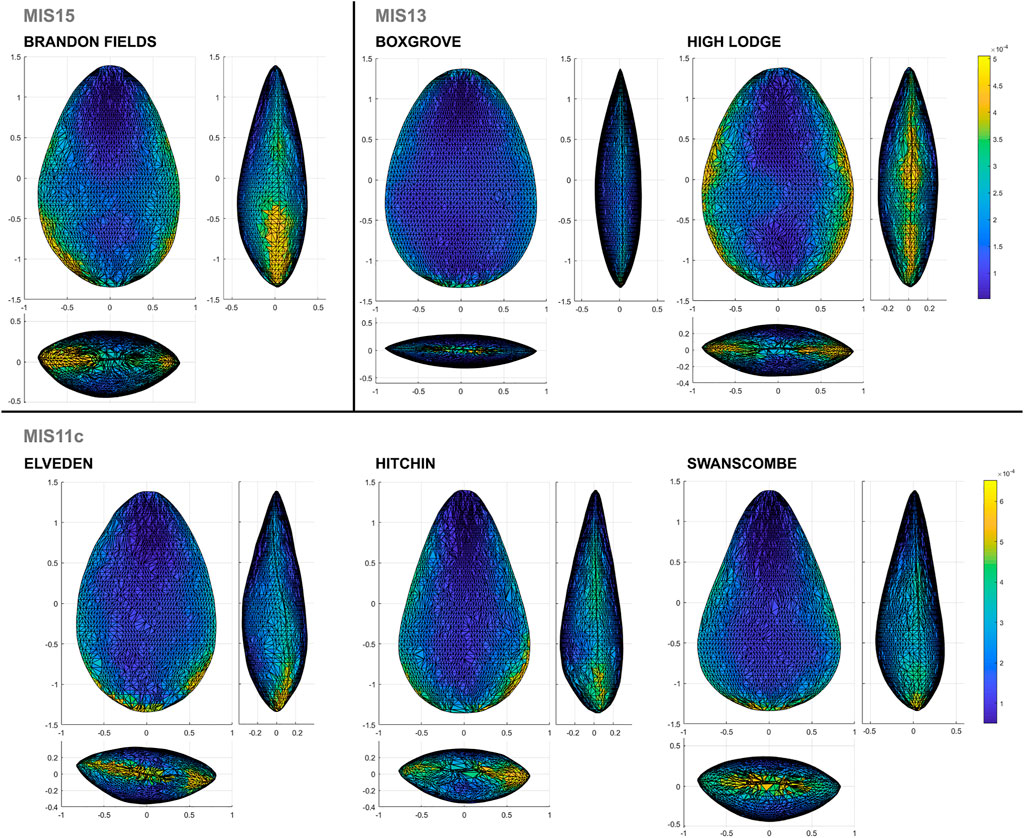
FIGURE 3. The mean shapes of handaxes and cleavers. Color coding represents the relative degree of variability of each individual landmark reflecting the spatial distribution of variability across the tools.
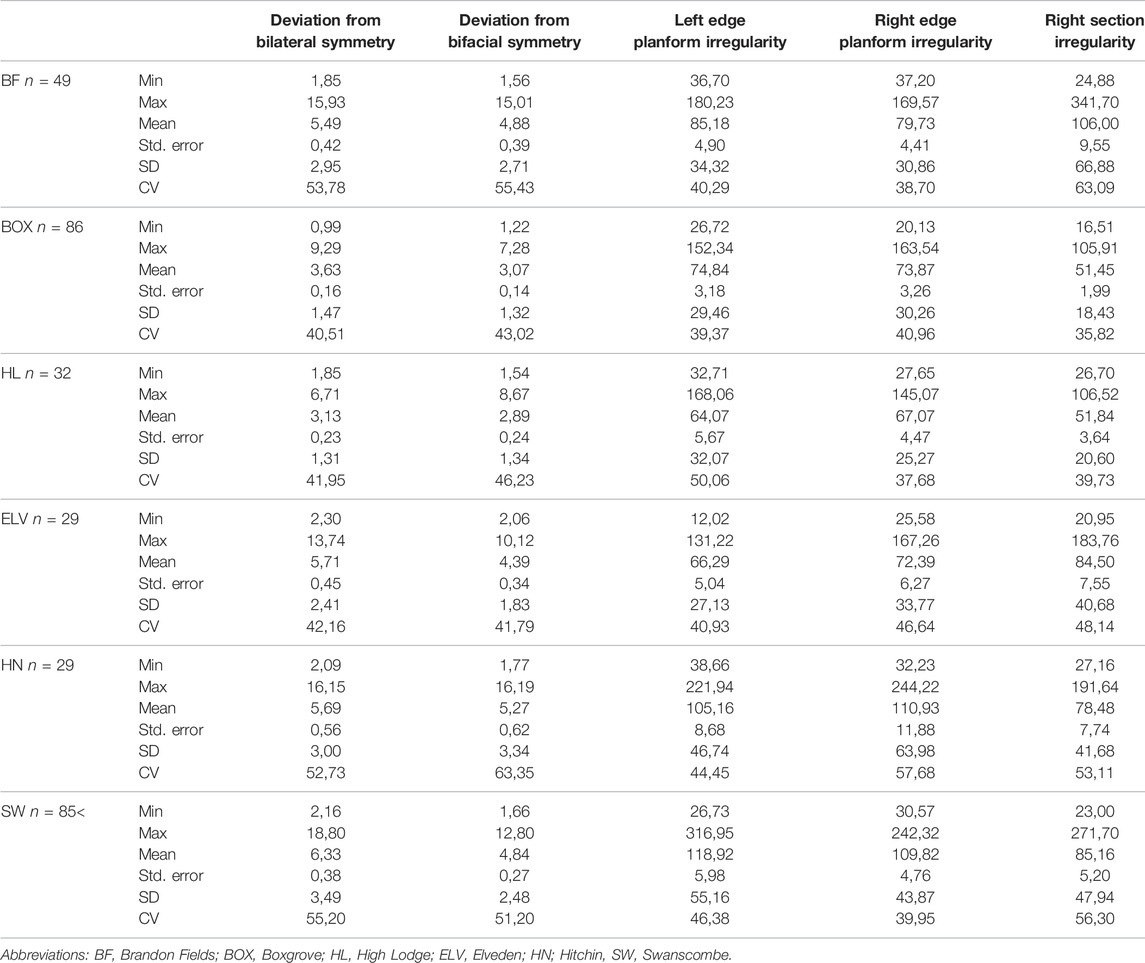
TABLE 4. Summary statistics for deviations from perfect bilateral and bifacial symmetry and edge irregularity.
The question remains as to whether their morphometrical differences are the consequence of different technological traditions and whether these morphological contrasts are accompanied by changes in the underlying technologies? To address these questions we have combined all the technological features (Table 1) in a Correspondence Analysis (Figure 4). Components 1, 2, and 3 explain 88.84% of the variability of our samples, and the contribution of each one of them varies depending on the site (Figure 4C).
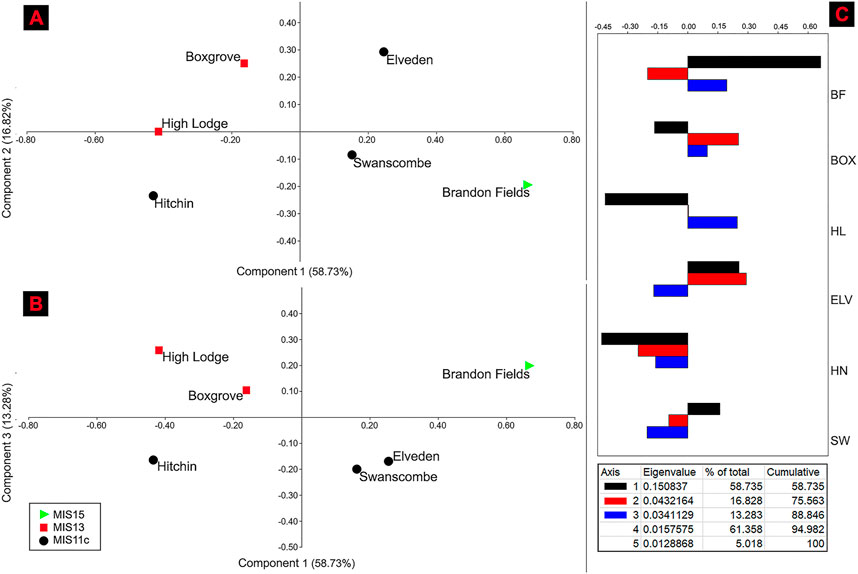
FIGURE 4. Correspondence Analysis (CA) resulting from combining all the technological features by sites (SOM Tables 1–4). (A) Component 1 and 2; (B) Components 1 and 3; (C) Components loadings per site. Abbreviations: BF, Brandon Fields; BOX, Boxgrove; HL, High Lodge; ELV, Elveden; HN; Hitchin, SW, Swanscombe.
MIS 13 sites occur in the same quadrants and represent the longest reduction sequences, with a strong consistency of approach in the technological strategies applied to the three parts of the tools (tip, mid-part, and butt). They are mainly shaped using two removal series, plus final retouch, with soft hammer percussion. Usually, the first series is very invasive and the second one, non-invasive. Removals have a limited effect on edges, which are straight and sinuous in profile view, with symmetric and, in a minor proportion, plano-convex silhouettes.
Our MIS 15 site, Brandon Fields, plots outside the range of MIS 13 sites for most components. This is due to a mix of features, shorter sequences on cobbles combined with longer shaping ones on unknown blanks; when examined at the level of technological features by handaxe zone (Figures 5, 6), mid-parts and butts are mainly shaped by only one removal series plus non-invasive final retouch focused on edges.
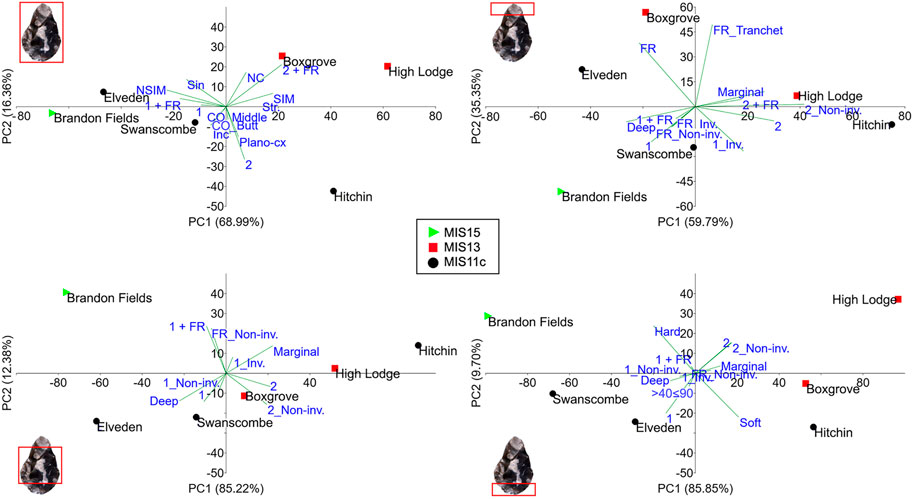
FIGURE 5. PCA (biplots) of the technological features, which have a major effect on each group. The four graphs correspond with the technological variables included in Figure 4 but divided in: (A) General aspects; (B) Distal part; (C) Mid-part; (D) Proximal part. In blue, technological features which contribute to the distribution of sites. Abbreviations: Hard, hard percussion; Soft, soft percussion; H/S, combined; 1, one removal series; 2, two removal series; 1+FR, one plus Final Retouch; 2+FR, two plus Final Retouch; CO_Butt, cortex in butts; CO_Butt + Mid, cortex in butts and mid-parts; CO_All, cortex in the whole instrument; CO_Midddle, Cortex in the mid-parts; NC, no cortex; Str, straight edges; Sin, sinuous edges; Inc, incurved edges; SIM, symmetric profile; NSIM, non-symmetric profile; Pl-cx, Plano-convex profile; Deep, deep effect on edges; Marginal, marginal effect on edges; 1_Inv., first invasive removal series; 1_Non-inv., first non-invasive removal series; 2_Inv., second invasive removal series; 2_Non-inv., second non-invasive removal series; FR. Inv., invasive Final Retouch; FR. Non-inv., non-invasive Final Retouch; FR_Tranchet, Distal tranchet Final Retouch).
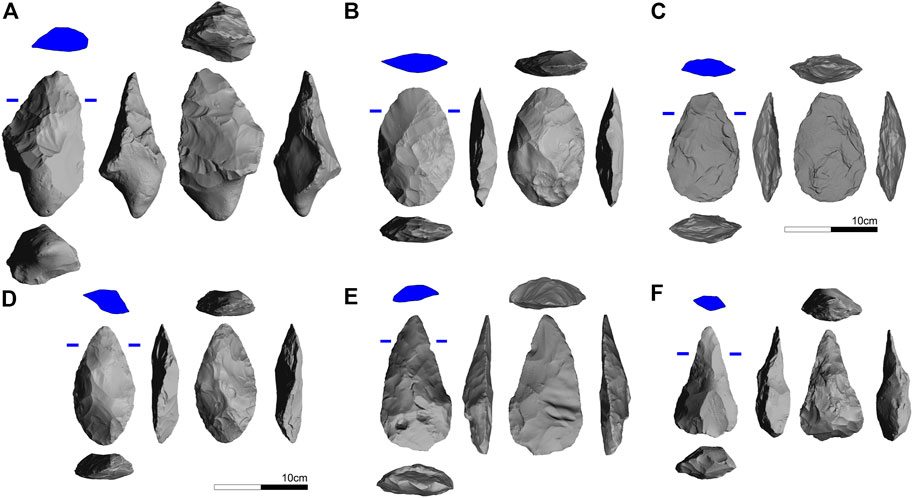
FIGURE 6. Handaxe examples from each site: (A), Brandon Fields (Sturge_14); (B), Boxgrove (Q1B_Unit4_95_L1097); (C), High Lodge (3,177); (D), Elveden (Sturge_92); (E), Hitchin (272); (F) Swanscombe (16). In blue, transversal sections at upper fifth.
The MIS11c handaxes are more variably distributed in the graphs. Elveden and Swanscombe have similar values for components 1 and 3, but differ on component 2 (Figure 4). This likely reflects cortical presence and the tip shaping strategy. Elveden tips are shaped with final retouch in more than 65% of cases, removing previous technological information. In 40% of implements, this corresponds with tranchet removals. Swanscombe presents a high proportion of residual cortex, concentrated on butts and mid-parts. Their tips are shaped in a variety of ways, combining 1 and 2 removal series with invasive and non-invasive final retouch. Tranchet blows are scarce. The common ground between Elveden and Swanscombe is the mid and butt shaping strategy. Mid-parts are made with a first invasive removal series combined in some cases with a non-invasive one. The butts are shaped with only one removal series. The difference between them on these parts is that Elveden presents a small proportion of two combined removal series on butts, and always a small proportion of final retouch. On the other hand, Hitchin differs from Swanscombe and Elveden on component 1 (Figure 4), due to the high intra-site variety of technological features, supporting recent contentions that two separate pulses of occupation are contained in this assemblage (White et al., 2019; Shipton and White 2020), one similar to Elveden and the other to Swanscombe. To see more details on technological features, see SOM Tables 2–5.
Despite technological differences between all the sites, a Kruskal–Wallis test for variation in medians across all components (Figure 4) indicates that there is no significant inter-site heterogeneity: Component 1 vs. Component 2, p = 0.8728; Component 1 vs. Component 3, p = 0.8728. Although the technology varies, these assemblages are representing the same technology with a different combination of features, dependent on the knapping aims.
SDI values show high intra-site variability, with medians in the 1 to 3.5 range (Figure 7). Elveden represents the opposite case, with the highest SDI values. In general terms, there is a clear relation between number of scars and volume of tools (cm3), except in the case of Boxgrove (Table 5), which presents the lowest values. At this site there is a particular circumstance, where there is a frequent fracturing of blanks during the knapping process, due to internal fissures and geodes. This leads to the loss of the relationship between the metric characteristics of the original blank and the metrical features of the final tool. During this breakage process there is a loss of a part of the initial scar information (SOM Figure 1), which is reflected in the relation between the SDI value and the tool’s volume (García-Medrano et al., 2019).
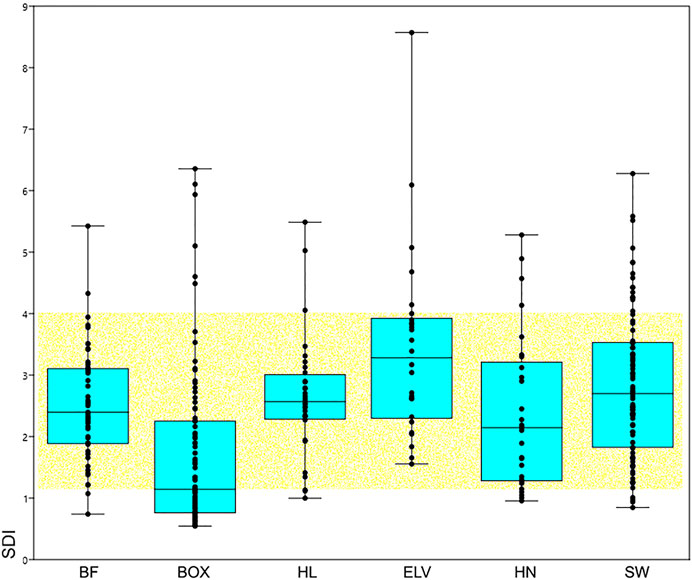
FIGURE 7. Boxplot with jitter of SDI (scars per in2) distribution per sites. Abbreviations: BF, Brandon Fields; BOX, Boxgrove; HL, High Lodge; ELV, Elveden; HN; Hitchin, SW, Swanscombe.
Discussion
Long Term Trends and Regionalization of Technology
The significance of variation in handaxe shape has long been a focus of discussion in Britain, where cyclical, climatically-forced fluctuations in ecology, geography and habitability have been argued to provide a discontinuous but understandable pattern of arrival, settlement and abandonment (Preece, 1995; White and Schreve, 2001; Hijma et al., 2012; Ashton et al., 2016; Hosfield and Cole, 2018; Ashton and Davis, 2021; Ashton and Davis, 2021).
The present analysis of six British Acheulean sites from MIS 15 to MIS 11c allows technological and morphological intra and inter-site variation to be explored further. Our results indicate that there are statistically significant morphological groups (Figure 8) that accord with previous studies (Roe, 1968; Bridgland and White, 2014, 2015; White, 2015; Ashton, 2016; White et al., 2018, 2019; Davis and Ashton 2019; Shipton and White, 2020; Davis et al., 2021a; Ashton and Davis 2021). The analysis shows that most of the tools occupy overlapping shape space for the first two principal components. Nevertheless, these groups are statistically distinguishable. There is a clear distance from the highest morphometrical variability at Brandon Fields to MIS 13 sites, which reflect the most ovate and standardized assemblages. MIS 11c sites appear to reflect two main shape groups: Elveden, which has a tendency to oval shapes, similar to those from MIS 13; and the more pointed planforms at Swanscombe and Hitchin.
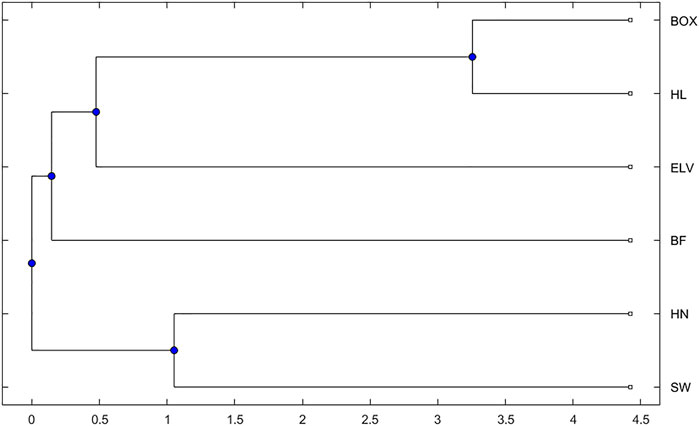
FIGURE 8. Cluster and distances of sites from the Geometric Morphometrics analysis. Abbreviations: BF, Brandon Fields; BOX, Boxgrove; HL, High Lodge; ELV, Elveden; HN; Hitchin, SW, Swanscombe.
The characteristic handaxes from Brandon Fields of thick, elongated forms with irregular edges, have parallels with several other early sites in eastern and southern England. Maidscross Hill, 4 km south-west of Brandon Fields, also lies on the Timworth Terrace of the Bytham River with the majority of handaxes being abraded and of a similar form to those from Brandon Fields, probably dating to MIS 15 (Flower, 1869; Davis et al., 2021a; Lewis et al., 2021). The complex sediments at Warren Hill a further 8 km to the south of Maidscross Hill, reflect the final iteration of the Bytham River, dating to MIS 12. It has three intermixed, derived assemblages, the most abraded of which is characterised by handaxes similar to those from Brandon Fields and Maidscross Hill (Roe, 1968; Wymer, 1985; Davis et al., 2021a; Lewis et al., 2021). This part of the assemblage is also argued to date to MIS 15. Beyond the Bytham system, Fordwich (Kent) is on a high terrace of the River Stour and has long been suggested to have an early date (Bridgland et al., 1998; Bridgland and White, 2014; White, 2015). Current fieldwork is investigating the context of the artefacts alongside a new dating programme with initial results supporting a pre-Anglian age (Key, in review). Although there is variation in handaxe form, many are elongated, thick ovate shapes with evidence of occasional soft hammer use. Roe (1968) placed the assemblage in his Group V, alongside the “worn series” from Warren Hill. Finally, Farnham on the River Wey in Surrey has artefacts from several terraces, with a small assemblage of handaxes from the highest and oldest Terrace A (Oakley, 1939; Roe, 1968). They were also placed by Roe in his Group V, united by “the coarse character of the handaxe industries belonging to it” (Roe, 1968, 65). Although precise dating is lacking for some sites, there does appear to be a group of handaxe assemblages that adhere to the form of those from Brandon Fields, probably dating to MIS 15.
From MIS 15 to 13, there is a transition towards a consistent technological approach with the maximum development of shaping strategies through several removal series plus final retouch on the whole perimeter of the tool, as represented by the late MIS 13 sites of Boxgrove and High Lodge. The high degree of invasiveness of this technology has a clear effect on the refinement of handaxes, which increase by 28% (SOM Table 1). These sites show the consistency of the technology from a technological and morphometrical point of view, with high standardization values and a correspondence between technology and morphometry. They tend towards refined ovate forms with soft hammer flaking, marginal trimming of the middle and butt portions, and are also characterised by frequent use of tranchet sharpening. Similar handaxes have been noted from Corfe Mullen (Roe, 2001; McNabb et al., 2012; Davis, 2013) and Ridge Gravel Pit (Davis, 2013; Davis et al., 2021b) in the Solent Basin, where the terrace gravels have been tentatively attributed to MIS 13. The Boxgrove assemblage was excavated after Roe’s (1968) analysis, but Corfe Mullen and High Lodge were both placed in his Group VII.
From MIS 11c, the technology behind the morphological groups (oval vs. pointed) does not reflect the particularities used to define each site by itself. There is variation in the combination of the same technological features, adapted to the final shaping aim. Technology reveals less standardization, with the major heterogeneity documented on tips, but without any statistically significant difference. The technology acquired a new sense of plasticity, becoming flexible and adapted to the features of the blank and towards achieving the final template. Thus, the only difference between sites is the relative abundance of particular features over others. For example, we can associate the more oval, refined and twisted-profile shapes of Elveden with a longer shaping sequence around the whole perimeter of tools, with very invasive removal series, including butts, and a frequent use of tranchet blows on tips. By contrast, for Swanscombe these sequences were adapted, keeping a significant part of the original cortex on butt and mid-parts, and with tips shaped by the combination of a first invasive removal series, a second non-invasive one, and then final retouch. The knappers’ emphasis on the distal ends, reduced the tip width, creating a shift of the maximum width to the mid to butt parts of tools. Hitchin is more difficult to interpret, due to its high variability.
Exploring the relation between width and thickness at the tip (at 1/5 Length) and butt (at 4/5 Length), we can detect that tip thickness is similar between sites and without any chronological pattern. Nevertheless, the flaking on tips produces a progressive chronological decrease of tip width (Figure 9). Tips are wider in oval samples, and narrow in pointed tools. In this case, butts reflect greater variability than tips, without any clear pattern. The only aspect to highlight is the small butt width of Elveden tools.
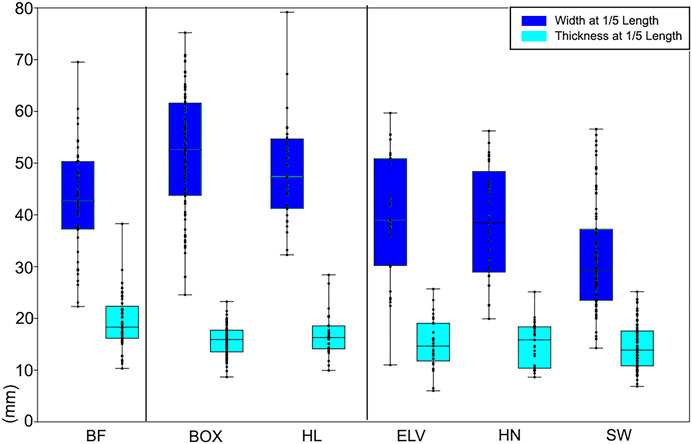
FIGURE 9. Boxplot with jitter of Tip width and thickness. Abbreviations: BF, Brandon Fields; BOX, Boxgrove; HL, High Lodge; ELV, Elveden; HN; Hitchin, SW, Swanscombe.
The ovate to cordiform-shaped handaxes from Elveden, often with twisted profiles, have possible parallels with other contemporary sites in East Anglia. The small assemblage from Barnham (7 km to the east) contains several twisted ovates (Davis and Ashton, 2019), while ovates also predominate in the small assemblage from Beeches Pit (10 km to the south; Gowlett et al., 2005). A further site is Foxhall Road in Ipswich (50 km south-east of Elveden), where twisted ovates were recovered from lacustrine clays in the excavations by Nina Layard (1904, 1906). Recent reassessment has interpreted the clays as Hoxnian lake beds (White and Plunkett, 2004) with unpublished OSL dates of 416 ± 36 ka and 434 ± 54 ka (see White et al., 2019).
The handaxes from the Middle Gravels at Swanscombe are typically small, pointed forms with thick butts that sometimes retain cortex. There are other sites on the same Orsett Heath/Boyn Hill Thames terrace as Swanscombe, which can be broadly attributed to MIS 11. Chadwell St Mary is 7 km downstream, where at least 126 handaxes were recovered from a series of gravel pits and have similar pointed forms to those from Swanscombe (Roe, 1968; Wymer, 1985). Both sites were placed in Roe, (1968). The East Burnham sites of Cooper’s and Deverill’s Pits are 60 km upstream (Lacaille, 1939; Wymer 1968) and of 300 recorded handaxes, most are again pointed in form.
Unlike earlier periods, there do appear to be regional patterns in MIS 11. Palynology and molluscan biostratigraphy suggest that the assemblage from Swanscombe is contemporary to those from Elveden, Barnham, and Beeches Pit, all attributed to the transition between Hoxnian pollen zones II and III with the resolution of the dating perhaps as little as 2,000 to 3,000 years (Ashton, 2016).
Occupation at Hitchin seems occur in the early interglacial aqueous sediments (Ho II), as well as the overlying colluvial “brickearth” (post-Hoxnian sensu stricto?), and the admixture of these two has probably caused the Hitchin assemblage to be mis-classified. Unfortunately, it has not proved possible to distinguish the two series on the basis of condition, and in the absence of documentary record, only new field investigations will be able to resolve this.
The broader implications of these results are explored below.
Implications for Population Dynamics and Cultural Transmission in Middle Pleistocene Europe
From our study we can surmise that technology reflects an underlying continuum of knowledge accumulation, with small technical variations contributing to the morphological groups identified. The results suggest that there are long-term technological trends from MIS 15 through to MIS 13. These include the broad maintenance of the bifacial concept with the increase in soft-hammer flaking that enabled the production of thinner tools with more regular, functional edges. The relatively simple handaxe forms of MIS 15 saw a trajectory of gradual functional improvement in MIS 13 through better and more extensive cutting edges with sharpening or resharpening by tranchet blows to the tip. This specific practice may also reflect greater curation of handaxes during MIS 13 (Emery, 2010). If Britain was depopulated during MIS 14, then the results suggest that the returning populations in MIS 13 come from source areas within western or southern Europe (e.g. Antoine et al., 2016), without any clear indication of innovation from further afield.
The maintenance of technology and form in late MIS 13 could suggest strong cultural links across areas of up to 300 km. Alternatively it could reflect rapid colonisation by related groups with the conservative maintenance of more isolated practice through strong social norms. A further option is that colonisation of these areas was of short duration with insufficient time for diversification from established practice. Whatever the answer, it is probable that normative behaviour, governing the form handaxes should take and the techniques used to make and re-sharpen them, was established by MIS 13 (Shipton and White, 2020).
By MIS 11 there is a pattern of regionalisation in material culture, with distinctions in handaxe forms between the Thames Valley and central East Anglia. It has previously been suggested that these regions could reflect related group territories with potential radii of c. 30–40 km (Davis and Ashton, 2019; Shipton and White, 2020; Ashton and Davis, 2021). This order of territory size in temperate environments has been argued to be sufficient to support groups of c. 150 people, dependent on the technological ability to convert usable biomass into food (Ashton and Davis, 2021). A similar size for groups, or related sub-groups, is also suggested to be biologically viable as a breeding population (Wobst, 1974), and furthermore corresponds with the number of maintainable relationships in the Social Brain Hypothesis (Dunbar, 1998, 2003).
If the East Anglian and Thames Valley MIS 11 sites do represent different territories, then their contemporaneity and marked distinction in material culture would suggest different populations entering Britain, rather than in situ divergence. The East Anglian sites could relate to populations arriving via the East Anglian rivers, such as the Suffolk Stour, or the Waveney, while Swanscombe, Chadwell St Mary and East Burnham are all linked by the River Thames. Hitchin could conceivably have multiple periods of occupation, and lying midway between the two regions could have archaeological signatures from both. The duration of the East Anglian sites is hard to gauge, but an important contribution of Swanscombe is the persistent manufacture of the same forms of handaxes throughout the 2 m depth of the Middle Gravels, indicating a stable population for several thousand years.
The regionalisation of material culture by MIS 11 has important implications for the interpretation of lithic assemblages beyond Britain. Ashton and Davis (2021) suggested the Cultural Mosaic Model, whereby in stable environments different cultural expressions developed in part as a reflection of local resources and needs. Changes in environment would trigger shifts in population with an increase in exchange of technological knowledge, acculturation and increased gene-flow. This enabled the transmission of technological practice on a broader scale, such as western and central Europe, where by MIS 11 there is evidence for efficient hunting, skilled butchery, wood-, hide- and bone-working, and the use of fire at several sites across the region (Warren, 1911; Thieme, 1997 the use of fire; Roberts and Parfitt, 1999; Gowlett et al., 2005; Voormolen, 2008; Roebroeks and Villa, 2011; Schoch et al., 2015; van Kolfschoten et al., 2015; Ravon et al., 2016a, 2016b, 2022; Zutovski and Barkai, 2016; Milks et al., 2019).
Conclusion
The results of this paper have provided answers to the questions set out in the introduction. The WEAP method as applied to the six sites supports previous work on the identification of chronologically and morphologically distinct groups of sites. Besides, the combination of technological and morphometry give us information at different scales. On the one hand, technology shows a continuum accumulation of knowledge, without abrupt changes. There is a clear transition from a standardization of technology until MIS 13 and then, a plasticity on how this technology is applied at each site, depending in part on raw material quality as well as the final mental template. On the other hand, morphometry reflects the higher degree of regionalization, especially from MIS 11.
Furthermore, there are technological developments that can be identified from MIS 15 sites to those of later periods. The developments are underpinned by increased use of soft hammer flaking, which enabled the production of thinner handaxes with more effective and even cutting edges and the deployment of specific forms of sharpening, such as tranchet finishing. The use of soft hammer also enabled the imposition of greater variety in form and the application of idiosyncratic techniques, such as twisted profiles. Variation in form is first fully expressed in MIS 11, where regional patterns can be identified, unlike earlier periods. These appear to be the expression of small-scale group identity over multi-generational timescales of several thousand years, indicating strong systems of social learning and an adherence to group norms. Normative behavior, as expressed in this case through handaxes, created stronger social bonds and better group cohesion (Shipton et al., 2021) which were arguably essential ingredients for survival of more dispersed populations in northern environments.
Data Availability Statement
The original contributions presented in the study are included in the article/Supplementary Material, further inquiries can be directed to the corresponding author.
Author Contributions
PG-M analyzed all lithic material, organized and analyzed database, analyzed the PG-M results and wrote the manuscript. PG-M and CS made all 3D models used to the PG-M analysis. CS and MW participated in data analysis, statistics and manuscript writing. MW and NA participated in manuscript writing. All authors contributed to manuscript revision, read, and approved the submitted version.
Funding
The contribution of PG-M is supported by a Beatriu de Pinós MSCA-COFUND (AGAUR). Besides, she also received a grant from the European Union’s Horizon 2020 research and innovation programme as part of a Marie Sklodowska-Curie project, “Western European Acheulean project, WEAP” (Grant No. 748316). The University of Bradford and Adrian Evans, through the “Fragmented Heritage AHRC Project”, lent us the scanner for part of the work. The latter has received financial support from the Spanish Ministry of Science and Innovation through the “María de Maeztu” program for Units of Excellence (Grant No. CEX 2019-000945-M). Research carried out at IPHES is in the context of projects Grant No. PGC 2018-093925-B-C32 (MICIN), 2017SGR-1040 (AGAUR), and 2019PFR-URV-91 (URV). The contribution of NA was supported by the Pathways to Ancient Britain Project funded by the Calleva Foundation.
Conflict of Interest
The authors declare that the research was conducted in the absence of any commercial or financial relationships that could be construed as a potential conflict of interest.
Publisher’s Note
All claims expressed in this article are solely those of the authors and do not necessarily represent those of their affiliated organizations, or those of the publisher, the editors and the reviewers. Any product that may be evaluated in this article, or claim that may be made by its manufacturer, is not guaranteed or endorsed by the publisher.
Acknowledgments
We are particularly grateful to the Hebrew University of Jerusalem, Leore Grosman and Antoine Muller, who helped us with the AGMT3-D software management. The analysis has been done between the Department Britain, Europe and Prehistory at Franks House (British Museum), and the Institut Català de Paleoecologia Humana i Evolució Social (IPHES-CERCA, Spain). We also thank editors and reviewers for all the revision and suggestions, which has highly contributed to improve the quality of this work.
Supplementary Material
The Supplementary Material for this article can be found online at: https://www.frontiersin.org/articles/10.3389/feart.2022.917207/full#supplementary-material
References
Antoine, P., Moncel, M.-H., Limondin-Lozouet, N., Locht, J.-L., Bahain, J.-J., Moreno, D., et al. (2016). Palaeoenvironment and Dating of the Early Acheulean Localities from the Somme River Basin (Northern France): New Discoveries from the High Terrace at Abbeville-Carrière Carpentier. Quat. Sci. Rev. 149, 338–371. doi:10.1016/j.quascirev.2016.07.035
Archer, W., and Braun, D. R. (2010). Variability in Bifacial Technology at Elandsfontein, Western Cape, South Africa: a Geometric Morphometric Approach. J. Archaeol. Sci. 37 (1), 201–209. doi:10.1016/j.jas.2009.09.033
Ashton, N., and Davis, R. (2021). Cultural Mosaics, Social Structure, and Identity: The Acheulean Threshold in Europe. J. Hum. Evol. 156, 103011. doi:10.1016/j.jhevol.2021.103011
Ashton, N., Lewis, S., Parfitt, S., Candy, I., Keen, D., Kemp, R., et al. (2005). Excavations at the Lower Palaeolithic Site at Elveden, Suffolk, UK. Proc. Prehist. Soc. 71, 1–61. doi:10.1017/s0079497x00000943
Ashton, N. M., Cook, J., Lewis, S. G., and Rose, J. (1992). High Lodge: Excavations by G. de G. Sieveking, 1962–68 and J. Cook, 1988. London: British Museum Press.
Ashton, N. M., Lewis, S. G., Parfitt, S. A., Davis, R. J., and Stringer, C. B. (2016). Handaxe and Non-handaxe Assemblages during Marine Isotope Stage 11 in Northern Europe: Recent Investigations at Barnham, Suffolk, UK. J. Quat. Sci. 31, 837–843. doi:10.1002/jqs.2918
Ashton, N. (2016). The Human Occupation of Britain during the Hoxnian Interglacial. Quat. Int. 409, 41–53. doi:10.1016/j.quaint.2015.11.055
Bloom, E. F. D. (1934). “Geology,” in Hitchin: Hitchin and District Regional Survey Association. Editor R. L. Hine, 26–51.The Natural History of the Hitchin Region
Boreham, S., and Gibbard, P. L. (1995). Middle Pleistocene Hoxnian Stage Interglacial Deposits at Hitchin, Hertfordshire, England. Proc. Geologists' Assoc. 106, 259–270. doi:10.1016/s0016-7878(08)80237-4
Bowen, D. Q. (1999). A Revised Correlation of Quaternary Deposits in the British Isles, 23. London: Geological Society Special Report.
Boyd, R., Richerson, P. J., and Henrich, J. (2011). The Cultural Niche: Why Social Learning Is Essential for Human Adaptation. Proc. Natl. Acad. Sci. U.S.A. 108, 10918–10925. doi:10.1073/pnas.1100290108
Bridgland, D. R., Schreve, D. C., Keen, D. H., and White, M. J. (1998). “Quaternary Drainage of the Kentish Stour,” in The Quaternary of Kent and Sussex. Field Guide. Editors J. B. Murton, C. A. Whiteman, M. R. Bates, D. R. Bridgland, A. J. Long, M. B. Robertset al. (London: Quaternary Research Association), 39–54.
Bridgland, D. R., and White, M. J. (2015). Chronological Variations in Handaxes: Patterns Detected from Fluvial Archives in North-West Europe. J. Quat. Sci. 30, 623–638. doi:10.1002/jqs.2805
Bridgland, D. R., and White, M. J. (2014). Fluvial Archives as a Framework for the Lower and Middle Palaeolithic: Patterns of British Artefact Distribution and Potential Chronological Implications. Boreas 43, 543–555. doi:10.1111/bor.12059
Clarkson, C. (2013). Measuring Core Reduction Using 3D Flake Scar Density: a Test Case of Changing Core Reduction at Klasies River Mouth, South Africa. J. Archaeol. Sci. 40, 4348–4357. doi:10.1016/j.jas.2013.06.007
Conway, B., McNabb, J., and Ashton, N. M. (1996). Excavations at Swanscombe, 1968–1972. London: British Museum Occasional. Paper 94.
Costa, A. G. (2010). “A Geometric Morphometric Assessment of Plan Shape in Bone and Stone Acheulean Bifaces from the Middle Pleistocene Site of Castel di Guido, Latium, Italy,” in New Perspectives on Old Stones: Analytical Approaches to Paleolithic Technologies. Editors S. L. Lycett, and P. R. E. Chauhan (New York: Springer), 23–41. doi:10.1007/978-1-4419-6861-6_2
Davis, R., Ashton, N., Hatch, M., Hoare, P. G., and Lewis, S. G. (2021a). Palaeolithic Archaeology of the Bytham River: Human Occupation of Britain during the Early Middle Pleistocene and its European Context. J. Quat. Sci. 36 (4), 526–546. doi:10.1002/jqs.3305
Davis, R., Ashton, N., Hatch, M., Hosfield, R., and Lewis, S. G. (2021b). Lower and Early Middle Palaeolithic of Southern Britain: the Evidence from the River Test. J. Paleo. Arch. 4, 23. doi:10.1007/s41982-021-00096-3
Davis, R., and Ashton, N. (2019). Landscapes, Environments and Societies: The Development of Culture in Lower Palaeolithic Europe. J. Anthropol. Archaeol. 56, 101107. doi:10.1016/j.jaa.2019.101107
Davis, R. J. (2013). Palaeolithic Archaeology of the Solent River: Human Settlement History and Technology. Unpublished PhD thesis. Reading: University of Reading.
Dean, L. G., Vale, G. L., Laland, K. N., Flynn, E., and Kendal, R. L. (2014). Human Cumulative Culture: a Comparative Perspective. Biol. Rev. 89, 284–301. doi:10.1111/brv.12053
Dennell, R. W., Martinón-Torres, M., and Bermúdez de Castro, J. M. (2011). Hominin Variability, Climatic Instability and Population Demography in Middle Pleistocene Europe. Quat. Sci. Rev. 30, 1511–1524. doi:10.1016/j.quascirev.2009.11.027
Dunbar, R. I. M. (1998). The Social Brain Hypothesis. Evol. Anthropol. 6, 178–190. doi:10.1002/(sici)1520-6505(1998)6:5<178::aid-evan5>3.0.co;2-8
Dunbar, R. I. M. (2003). The Social Brain: Mind, Language, and Society in Evolutionary Perspective. Annu. Rev. Anthropol. 32, 163–181. doi:10.1146/annurev.anthro.32.061002.093158
Emery, K. (2010). A Re-examination of Variability in Handaxe Form in the British Palaeolithic. Unpublished PhD Thesis. London: University College of London.
Evans, J. (1872). The Ancient Stone Implements, Weapons and Ornaments of Great Britain. New York: D. Appleton and Company.
Evans, J. (1897). The Ancient Stone Implements, Weapons and Ornaments of Great Britain. 2nd ed. New York: D. Appleton and Company.
Flower, J. W. (1869). On Some Recent Discoveries of Flint Implements of the Drift in Norfolk and Suffolk with Observations on the Theories Accounting for Their Distribution. Q. J. Geol. Soc. 25, 449–460. doi:10.1144/gsl.jgs.1869.025.01-02.79
García-Medrano, P., Maldonado-Garrido, E., Ashton, N. M., and Ollé, A. (2020). Objectifying Processes: The Use of Geometric Morphometrics and Multivariate Analyses on Acheulean Tools. J. Lithic Technol. 7. doi:10.2218/jls.4327
García-Medrano, P., Ollé, A., Ashton, N., and Roberts, M. B. (2019). The Mental Template in Handaxe Manufacture: New Insights into Acheulean Lithic Technological Behavior at Boxgrove, Sussex, UK. J. Archaeol. Method Theory 26, 396–422. doi:10.1007/s10816-018-9376-0
Gowlett, J. A. J., Hallos, J., Hounsell, S., Brant, V., and Debenham, N. C. (2005). Beeches Pit – Archaeology, Assemblage Dynamics and Early Fire History of a Middle Pleistocene Site in East Anglia, UK. Eurasian Prehistory 3, 3–38.
Henrich, J., and Tennie, C. (2017). “Cultural Evolution in Chimpanzees and Humans,” in Chimpanzees and Human Evolution. Editors M. Muller, R. Wrangham, and D. Pilbeam (Cambridge: Harvard University Press), 645–702.
Henrich, J. (2015). How Culture Is Driving Human Evolution, Domesticating Our Species, and Making Us Smarter. Princeton: Princeton University Press. doi:10.2307/j.ctvc77f0dThe Secret of Our Success
Herzlinger, G., and Goren-Inbar, N. (2020). Beyond a Cutting Edge: a Morpho-Technological Analysis of Acheulian Handaxes and Cleavers from Gesher Benot Ya'aqov, Israel. J. Paleo Arch. 3, 33–58. doi:10.1007/s41982-019-00033-5
Herzlinger, G., Goren-Inbar, N., and Grosman, L. (2017). A New Method for 3D Geometric Morphometric Shape Analysis: The Case Study of Handaxe Knapping Skill. J. Archaeol. Sci. Rep. 14, 163–173. doi:10.1016/j.jasrep.2017.05.013
Herzlinger, G., and Grosman, L. (2018). AGMT3-D: A Software for 3-D Landmarks-Based Geometric Morphometric Shape Analysis of Archaeological Artifacts. PLoS One 13, e0207890. doi:10.1371/journal.pone.0207890
Hijma, M. P., Cohen, K. M., Roebroeks, W., Westerhoff, W. E., and Busschers, F. S. (2012). Pleistocene Rhine-Thames Landscapes: Geological Background for Hominin Occupation of the Southern North Sea Region. J. Quat. Sci. 27, 17–39. doi:10.1002/jqs.1549
Hoggard, C. S., McNabb, J., and Cole, J. N. (2019). The Application of Elliptic Fourier Analysis in Understanding Biface Shape and Symmetry through the British Acheulean. J. Paleo Arch. 2, 115–133. doi:10.1007/s41982-019-00024-6
Hosfield, R. T., and Cole, J. (2018). Earliest Europeans: Integrating Perspectives from Archaeology, Palaeoanthropology and Palaeoclimatology. Quat. Sci. Rev. 208, 140–142. doi:10.1016/j.quascirev.2019.02.010
Lacaille, A. D. (1939). The Palaeolithic Contents of the Gravels at East Burnham, Bucks. Antiq. J. 19, 166–181. doi:10.1017/s0003581500007642
Layard, N. F. (1906). A Winter's Work on the Ipswich Palaeolithic Site. J. Anthropol. Inst. G. B. Irel. 36, 233–236. doi:10.2307/1193259
Layard, N. F. (1904). Further Excavations on a Palaeolithic Site in Ipswich. J. Anthropol. Inst. G. B. Irel. 34, 306–310. doi:10.2307/2843104
Lewis, S. G., Ashton, N., Davis, R., Hatch, M., Hoare, P. G., Voinchet, P., et al. (2021). A Revised Terrace Stratigraphy and Chronology for the Early Middle Pleistocene Bytham River in the Breckland of East Anglia, UK. Quat. Sci. Rev. 269, 107113. doi:10.1016/j.quascirev.2021.107113
Lycett, S. J., von Cramon-Taubadel, N., and Foley, R. A. (2006). A Crossbeam Co-ordinate Caliper for the Morphometric Analysis of Lithic Nuclei: a Description, Test and Empirical Examples of Application. J. Archaeol. Sci. 33 (6), 847–861. doi:10.1016/j.jas.2005.10.014
Marr, J. E. (1921). I.-Excavations at High Lodge, Mildenhall, in 1920, A.D. Proc. Prehist. Soc. East Angl. 3, 353–367. doi:10.1017/s0958841800024492
McNabb, J., Hosfield, R., Dearling, K., Barker, D., Strutt, K., Cole, J., et al. (2012). Recent Work at the Lower Palaeolithic Site of Corfe Mullen, Dorset, England. Proc. Prehist. Soc. 78, 35–50. doi:10.1017/s0079497x00027092
Milks, A., Parker, D., and Pope, M. (2019). External Ballistics of Pleistocene Hand-Thrown Spears: Experimental Performance Data and Implications for Human Evolution. Sci. Rep. 9, 820. doi:10.1038/s41598-018-37904-w
Mithen, S. (1994). Technology and Society during the Middle Pleistocene: Hominid Group Size, Social Learning and Industrial Variability. Caj 4, 3–32. doi:10.1017/s0959774300000949
Moncel, M.-H., Ashton, N., Lamotte, A., Tuffreau, A., Cliquet, D., and Despriée, J. (2015). The Early Acheulian of North-Western Europe. J. Anthropol. Archaeol. 40, 302–331. doi:10.1016/j.jaa.2015.09.005
Oakley, K. P. (1939). A Survey of the Prehistory of the Farnham District (Surrey): Part I, Geology and Palaeolithic Studies. Surrey Archaeol. Collect. (SI), 3–58.
Ovey, C. D. (1964). The Swanscombe Skull. A Survey of Research on a Pleistocene Site. Royal Anthropological Institute Occasional Paper 20. London: Royal Anthropological Institute of Great Britain and Ireland.
Pargeter, J., Khreisheh, N., and Stout, D. (2019). Understanding Stone Tool-Making Skill Acquisition: Experimental Methods and Evolutionary Implications. J. Hum. Evol. 133, 146–166. doi:10.1016/j.jhevol.2019.05.010
Paterson, T. T., and Fagg, B. E. B. (1940). Studies on the Palaeolithic Succession in England No. II. The Upper Brecklandian Acheul (Elveden). Proc. Prehist. Soc. 6, 1–29. doi:10.1017/s0079497x00020417
Penkman, K. E. H., Preece, R. C., Bridgland, D. R., Keen, D. H., Meijer, T., Parfitt, S. A., et al. (2011). A Chronological Framework for the British Quaternary Based on Bithynia Opercula. Nature 476, 446–449. doi:10.1038/nature10305
Pope, M., Parfitt, S., and Roberts, M. (2020). The Horse Butchery Site. A High Resolution Record of Lower Palaeolithic Hominin Behaviour at Boxgrove, 23. Soffolk: UK. SpoilHeap PublicationsLavenham Press.
Pradhan, G. R., Tennie, C., and van Schaik, C. P. (2012). Social Organization and the Evolution of Cumulative Technology in Apes and Hominins. J. Hum. Evol. 63, 180–190. doi:10.1016/j.jhevol.2012.04.008
Preece, R. C. (1995). Island Britain: A Quaternary Perspective, 96. London: Geological Society. Special publication. doi:10.1144/gsl.sp.1995.096.01.01
Preece, R. C., and Parfitt, S. A. (2012). The Early and Early Middle Pleistocene Context of Human Occupation and Lowland Glaciation in Britain and Northern Europe. Quat. Int. 271, 16–28. doi:10.1016/j.quaint.2012.04.018
Ravon, A.-L., Gaillard, C., and Monnier, J.-L. (2016a). Menez-Dregan (Plouhinec, Far Western Europe): The Lithic Industry from Layer 7 and its Acheulean Components. Quat. Int. 411, 132–143. doi:10.1016/j.quaint.2015.12.097
Ravon, A.-L., García-Medrano, P., Moncel, M.-H., and Ashton, N. (2022). Acheulean Variability in Western Europe: The Case of Menez-Dregan I (Plouhinec, Finistère, France). J. Hum. Evol. 162, 103103. doi:10.1016/j.jhevol.2021.103103
Ravon, A.-L., Monnier, J.-L., and Laforge, M. (2016b). Menez-Dregan I, Layer 4: A Transitional Layer between the Lower and Middle Palaeolithic in Brittany. Quat. Int. 409, 92–103. doi:10.1016/j.quaint.2015.07.066
Reid, C. (1898). The Interglacial Deposits at Hitchin and Their Relationship to the Glacial Epoch. Trans. Herts. Nat. Hist. Soc. Field Club 10, 14–22.
Reid, C. (1897). The Palaeolithic Deposits at Hitchin and Their Relation to the Glacial Epoch. Proc. R. Soc. Lond. 61, 40–49.
Roberts, M. B., and Parfitt, S. A. (1999). Boxgrove. A Middle Pleistocene Hominid Site at Eartham Quarry. West Sussex. London: BoxgroveEnglish Heritage.
Roe, D. A. (1994). “A Metrical Analysis of Selected Sets of Handaxes and Cleavers from Olduvai Gorge,”. Editors M. D. Leakey, and M. D. Roe (Olduvai Gorge: Cambridge University Press), 5, 146–234.
Roe, D. A. (1968). British Lower and Middle Palaeolithic Handaxe Groups. Proc. Prehist. Soc. 34, 1–82.
Roe, D. A. (2001). “Some Earlier Palaeolithic Find-Spots of Interest in the Solent Region,” in Palaeolithic Archaeology of the Solent River. Editors F. F. Wenban-Smith, and R. T. Hosfield (London: Lithic Studies Society Occasional Paper No. 7), 47–56.
Roebroeks, W. (2006). The Human Colonisation of Europe: where Are We? J. Quat. Sci. 21, 425–435. doi:10.1002/jqs.1044
Roebroeks, W., and Villa, P. (2011). On the Earliest Evidence for Habitual Use of Fire in Europe. Proc. Natl. Acad. Sci. U.S.A. 108, 5209–5214. doi:10.1073/pnas.1018116108
Rosenberg-Yefet, T., Shemer, M., and Barkai, R. (2021). Acheulian Shortcuts: Cumulative Culture and the Use of Handaxes as Cores for the Production of Predetermined Blanks. J. Archaeol. Sci. Rep. 36, 102822. doi:10.1016/j.jasrep.2021.102822
Schoch, W. H., Bigga, G., Böhner, U., Richter, P., and Terberger, T. (2015). New Insights on the Wooden Weapons from the Paleolithic Site of Schöningen. J. Hum. Evol. 89, 214–225. doi:10.1016/j.jhevol.2015.08.004
Schreve, D. C. (2001). Differentiation of the British Late Middle Pleistocene Interglacials: the Evidence from Mammalian Biostratigraphy. Quat. Sci. Rev. 20, 1693–1705. doi:10.1016/s0277-3791(01)00033-6
Shipton, C. B. K. (2013). A Million Years of Hominin Sociality and Cognition: Acheulean Bifaces in the Hunsgi-Baichbal Valley, India. Oxford: Archaeopress, 9–123.
Shipton, C., and Clarkson, C. (2015b). Flake Scar Density and Handaxe Reduction Intensity. J. Archaeol. Sci. Rep. 2, 169–175. doi:10.1016/j.jasrep.2015.01.013
Shipton, C., and Clarkson, C. (2015a). Handaxe Reduction and its Influence on Shape: An Experimental Test and Archaeological Case Study. J. Archaeol. Sci. Rep. 3, 408–419. doi:10.1016/j.jasrep.2015.06.029
Shipton, C., Nielsen, M., and Di Vincenzo, F. (2021). “The Acheulean Origins of Normativity,” in Explorations in Archaeology and Philosophy (Springer), 197–212. doi:10.1007/978-3-030-61052-4_11
Shipton, C., and White, M. (2020). Handaxe Types, Colonization Waves, and Social Norms in the British Acheulean. J. Archaeol. Sci. Rep. 31, 102352. doi:10.1016/j.jasrep.2020.102352
Smith, R. A., and Dewey, H. (1913). IV.-Stratification at Swanscombe: Report on Excavations Made on Behalf of the British Museum and H. M. Geological Survey. Archaeologia 64, 177–204. doi:10.1017/s0261340900010729
Stout, D., Rogers, M. J., Jaeggi, A. V., and Semaw, S. (2019). Archaeology and the Origins of Human Cumulative Culture: A Case Study from the Earliest Oldowan at Gona, Ethiopia. Curr. Anthropol. 60, 309–340. doi:10.1086/703173
Thieme, H. (1997). Lower Palaeolithic Hunting Spears from Germany. Nature 385, 807–810. doi:10.1038/385807a0
Tomasello, M. (1999). The Cultural Origins of Human Cognition. Massachusetts: Harvard University Press.
van Kolfschoten, T., Parfitt, S. A., Serangeli, J., and Bello, S. M. (2015). Lower Paleolithic Bone Tools from the 'Spear Horizon' at Schöningen (Germany). J. Hum. Evol. 89, 226–263. doi:10.1016/j.jhevol.2015.09.012
Voormolen, B. (2008). Ancient Hunters, Modern Butchers. Schöningen 13II-4, a Kill-Butchery Site Dating from the Northwest European Lower Palaeolithic. Unpublished PhD Thesis. Leiden: University of Leiden.
Warren, S. H. (1911). A Piece of Worked Wood, Possibly the Point of a Palaeolithic Spear. Q. J. Geol. Soc. Lond. 67, 119.
Whitaker, W., Woodward, H. B., Bennett, F. J., Skertchly, S. B. J., and Jukes-Browne, A. J. (1891). The Geology of Parts of Cambridgeshire and of Suffolk (Ely, Mildenhall, Thetford). London: Memoir of the Geological Survey of Great Britain. HMSO.
White, M., Ashton, N., and Bridgland, D. (2019). Twisted Handaxes in Middle Pleistocene Britain and Their Implications for Regional-Scale Cultural Variation and the Deep History of Acheulean Hominin Groups. Proc. Prehist. Soc. 85, 61–81. doi:10.1017/ppr.2019.1
White, M. J., Bridgland, D. R., Schreve, D. C., White, T. S., and Penkman, K. E. H. (2018). Well-dated Fluvial Sequences as Templates for Patterns of Handaxe Distribution: Understanding the Record of Acheulean Activity in the Thames and its Correlatives. Quat. Int. 480, 118–131. doi:10.1016/j.quaint.2017.03.049
White, M. J. (2015). “Dancing to the Rhythms of the Biotidal Zone: Settlement History and Culture History in Middle Pleistocene Britain,” in Settlement, Society and Cognition in Human Evolution: Landscapes in Mind. Editors F. Wenban-Smith, F. Coward, and R. Hosfield (Cambridge: Cambridge University Press), 154–173.
White, M. J., and Plunkett, S. J. (2004). Miss Layard Excavates: A Palaeolithic Site at Foxhall Road, Ipswich, 1903–1905. Liverpool: Western Academic & Specialist Press.
White, M. J., and Schreve, D. C. (2000). Island Britain - Peninsula Britain: Palaeogeography, Colonisation, and the Lower Palaeolithic Settlement of the British Isles. Proc. Prehist. Soc. 66, 1–28. doi:10.1017/s0079497x00001742
Wobst, H. M. (1974). Boundary Conditions for Paleolithic Social Systems: a Simulation Approach. Am. Antiq. 39, 147–178. doi:10.2307/279579
Wymer, J. J. (1968). Lower Palaeolithic Archaeology in Britain as Represented by the Thames Valley. London: John Baker.
Keywords: middle pleistocene, britain, acheulean, technology, handaxes, geometric morphometrics (GM)
Citation: García-Medrano P, Shipton C, White M and Ashton N (2022) Acheulean Diversity in Britain (MIS 15-MIS11): From the Standardization to the Regionalization of Technology. Front. Earth Sci. 10:917207. doi: 10.3389/feart.2022.917207
Received: 10 April 2022; Accepted: 19 May 2022;
Published: 08 June 2022.
Edited by:
Marie-Hélène Moncel, Director of research CNRS-MNHN, FranceReviewed by:
Andrzej Wiśniewski, University of Wrocław, PolandRan Barkai, Tel Aviv University, Israel
James Cole, University of Brighton, United Kingdom
Copyright © 2022 García-Medrano, Shipton, White and Ashton. This is an open-access article distributed under the terms of the Creative Commons Attribution License (CC BY). The use, distribution or reproduction in other forums is permitted, provided the original author(s) and the copyright owner(s) are credited and that the original publication in this journal is cited, in accordance with accepted academic practice. No use, distribution or reproduction is permitted which does not comply with these terms.
*Correspondence: Paula García-Medrano, cGdhcmNpYW1lZHJhbm9AZ21haWwuY29t
 Paula García-Medrano
Paula García-Medrano Ceri Shipton
Ceri Shipton Mark White6
Mark White6 Nick Ashton
Nick Ashton